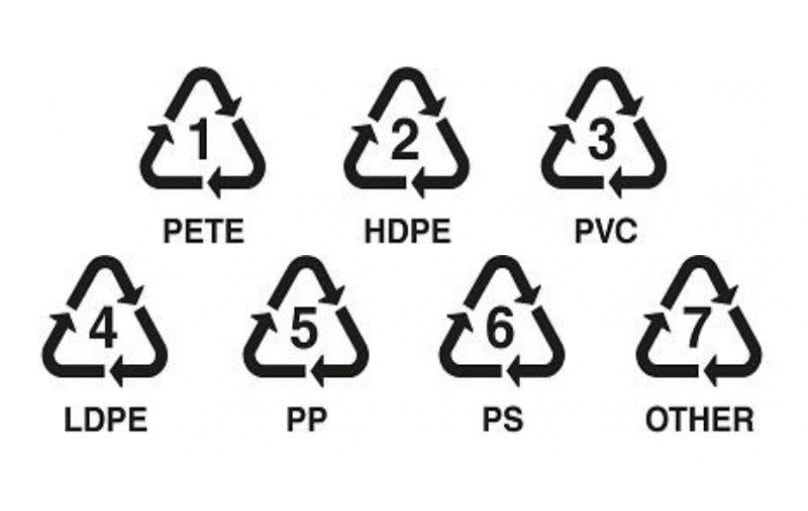

Recycling symbols on plastic items is a three-chasing-arrow forming a triangle numbered from one through seven which tells you the category of plastic an item is made of and how it can be recycled.
These symbols are generally called Resin Identification Code.
The symbols help identify whether a particular item can be recycled in a limited place or extensively recycled.
Each number represents the type of plastic and plastic commonly used in the same packaging.
With all the different rules and symbols, it can be confusing for consumers to identify exactly what each plastic recycling symbol represents and how to recycle it. Resin identification code usually helps recycling plants to sort out products.
If you observe critically, you will discover that biodegradable plastic and OXO biodegradable plastics usually come with a recycling symbol printed on them. In this post, you can learn what each plastic recycling symbol means, along with its sources and how they can be recycled.
According to National Geographic, over 91% of plastic has never been recycled. While the plastic resin symbol remains the same all over the world, the numbers 1-7 inside make a significant difference.
Note that not all plastics can be readily recycled. The chasing triangle symbol is merely an indicator of the type of plastic. Read on to learn about the seven plastic recycling symbols.
The most recycled plastic is polyethylene terephthalate (PET or PETE), which is found in peanut butter jars, ketchups, salad dressing bottles, water bottles, plastic soda bottles, microwavable food trays. PET is a clear, strong, inexpensive, and lightweight plastic that is easy to recycle.
Is PET or PETE recyclable? Yes.
PET or PETE is recycled into carpet, tote bags, straps, polar fleece, furniture, etc. as long as the plastic being recycled doesn’t have hazardous contaminants and meets purity standards.
While nearly as common is the high-density polyethylene or HDPE, these plastics are in the form of milk jugs, laundry detergent bottles, butter tubs, HDPE bags, motor oil bottles, well it is a little stronger than PETE.
Is HDPE recyclable? Yes, HDPE is easy to recycle.
HDPE is recycled into lumber, picnic tables, laundry detergent bottles, benches, oil bottles, shampoo bottles, pens, picor tiles, drainage pipe, etc.
Polyvinyl chlorides (PVC) are common when it comes to pipes; they come in cooking oil and shampoo bottles, wire jacketing, and cleaner spray bottles.
Is PVC recyclable? PVC products are extremely difficult to recycle because they contain hazardous chemicals that are poisonous to humans. This is why they have a 0.5% recycling rate and are made to be durable and long-lasting.
PVC is recycled into flooring, speed bumps, decks, mud-flaps, panelling, cables, mats, roadway gutters, etc.
Low-density polyethylene (LDPE) is flexible, lightweight, and convenient for packaging purposes. It is found in squeezable bottles and toys but is mainly used in furniture, frozen food packaging, shopping bags, squeezable bottles, clothing, etc.
Is LDPE recyclable? LDPE is very difficult to recycle and most times, it damages recycling equipment.
LDPE is recycled into landscaping ties, compost bins, trash can liners and cans, panelling, shipping envelopes, etc.
Polypropylene (PP) is a high melting plastic good for hot liquids, syrup, ketchup, medicine bottles.
Is PP recyclable? Yes.
PP is recycled into Battery cables, brushes, bicycle racks, signal lights, landscape borders, auto battery cases, rakes, pallets, etc.
Polystyrene (PS) is a versatile plastic, often regarded as “Styrofoam” because of its ability to turn into soft foam. It is lightweight, inexpensive, easily manufactured, and mostly disposed of.
PS is used in take-out containers, egg cartons, dinnerware, aspirin bottles, disposables plates, etc.
Is PS recyclable? PS is difficult and inefficient to recycle.
PS is recycled into Light switch plates, vents, insulation, foam packing, carry-out containers, egg cartons, rulers, etc.
“Other” recycling symbols refer to a miscellaneous category for all the plastics that didn’t fit into the other six categories. Fiberglass, PLA (polylactic acid), acrylics fabrics, 9polycarbonate, plexiglass, nylon, etc. falls into this category.
DVDs, baby bottles, water cooler bottles, sunglasses, and sports equipment are common products under the “7” symbol.
Are they recyclable? “Other” plastics like polycarbonate is hard plastic that often contains LEXAN and BPA, which can be very harmful to human health if not properly disposed of.
As such, products under the “7” symbol are rejected curbside but are sometimes accepted by mail-in programs or drop-off centers.
Other recycling symbols are recycled into Plastic lumber and custom-made products.
Every city and town has different recycling programs, so it is best to check your location’s rules to know exactly what you can recycle. As a plastic company in Malaysia, we encourage customers to stay informed about local recycling regulations.
Moreover, there are times when your recycling program may change what it collects, so endeavor to stay updated by reaching your plastic bag supplier.